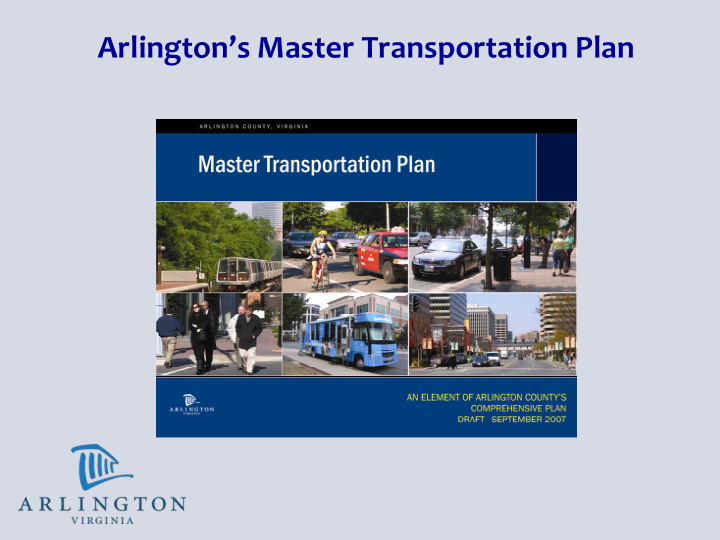



Arlington’s Master Transportation Plan
The Master Transportation Plan (MTP) Adopted in eight parts Goals & Policies element and MTP Map – adopted in 2007 Bicycle, Pedestrian and Demand and Systems Management elements ‐ adopted in 2008 Transit and Parking and Curb Space Management elements ‐ adopted in 2009 Streets element – adopted in 2011 2 2
Significance of the MTP Part of Arlington County’s Comprehensive Plan . Similar to the General Land Use Plan (GLUP) and Public Spaces Master Plan Provides policy guidance for development of other plans and projects Periodic reviews and amendments to the MTP undergo a public review process including hearings at commissions and County Board 3 3
MTP General Policies Integrate A. transportation with land use Support the design B. and operation of Complete Streets Manage travel C. demand and transportation systems 4 4
Travel Demand is Growing While Street Space is Limited 300,000 250,000 200,000 Households 150,000 Residents 100,000 Jobs 50,000 0 1970 1980 1990 2000 2010 2020 2030 5 5
Providing Alternatives to Driving is Essential 6 6
Addressing Traffic Concerns Prioritize safety of travel Provide more and better travel options and encourage alternatives to driving Effectively manage streets and other transportation facilities and services 7 7
Managing Transportation Facilities and Services Allocating curb space for highest use Adjusting signal timing for changing demands Achieving safer travel speeds and operations Increasing awareness of transit services 8 8
Goals and Policies Document Arlington’s transportation vision Goals and strategies General transportation policies Policies by mode (Streets, Transit, Pedestrians, Bicycles, Parking and Curb Space, Transportation Demand and System Management) 9 9
MTP Goals Provide high ‐ quality transportation services Move more people without more traffic Promote safety Establish equity Manage effectively and efficiently Advancing environmental sustainability 10 10
MTP Map Features Street network with a typology for streets Planned new facilities and improvement projects Transit system map – existing and planned routes and stations Bicycle system map – existing and planned trails, lanes and routes 11 11
Streets Element Objectives Well ‐ connected network of streets compatible with adjacent land uses Complete streets that accommodate all users Reducing traffic crashes and injuries Maximizing efficient use of streets Enhancing the human and natural environments 12 12
Streets Element Policies • Enhance the connectivity of the existing street network • Minimize the number and size of curb cuts in new developments • Include facilities in street projects to meet bicyclists’, pedestrians’, transit users’ and motorists’ needs • Alter streets as appropriate to address safety and access concerns • Design neighborhood streets to control vehicle speeds 13 13
Transit Element Objectives Increase transit service options Improve accessibility to transit for all Improve transit facilities Create multi ‐ modal transfer centers Expand transit information distribution and marketing Employ environmentally sensitive and sustainable technologies 14 14
Transit Element Policies • Make transit more accessible and convenient through transit ‐ oriented development practices • Expand access to transit by improved sidewalks ad upgraded street crossings • Promote transit use through direct marketing and real ‐ time information provision 15 15
Pedestrian Element Objectives Complete the walkway network Make the pedestrian network fully accessible and convenient for all Improve pedestrian safety Increase walking Maintain high ‐ quality pedestrian facilities 16 16
Pedestrian Element Policies • Build sidewalks along at least one side of all neighborhood streets. Emphasize projects near schools. • Improve connectivity with new trail links • Upgrade to comply with ADA standards • Use street redesign and enforcement to control vehicle speeds and reduce conflicts • Conduct on ‐ going safety education 17 17
Bicycle Element Objectives Complete the bikeway network Increase bicycle use Improve bicycle safety Manage and maintain the bikeway system Integrate bicycling with other transportation modes 18 18
Bicycle Element Policies • Provide bicycle facilities with all street improvement projects • Create community culture embracing bicycle use • Require bike parking & showers for new development • Conduct on ‐ going safe routes to schools program and safety education for children and adults 19 19
Parking & Curb Space Element On ‐ street parking policies: • Prioritize use of curb space; match types of uses to most appropriate locations • Increase curb space availability • Promote on ‐ street parking to calm traffic and support activity • Provide residential permits to limit overspill impacts in single ‐ family areas 20 20
Parking & Curb Space Element Off ‐ street parking policies: • Ensure minimum needs are met and excessive parking is not built • Discourage off ‐ street surface parking • Allow reduced parking near transit • Maximize sharing of spaces. Discourage assigned parking. • Provide reserved spaces for persons with disabilities 21 21
Demand and System Management Element Policies • Incorporate TDM plans for all site plan use permit developments • Incorporate TDM measures for all existing public buildings • Conduct regular travel surveys at Countywide and building levels • Coordinate with TDM efforts across the region 22 22
Recommend
More recommend